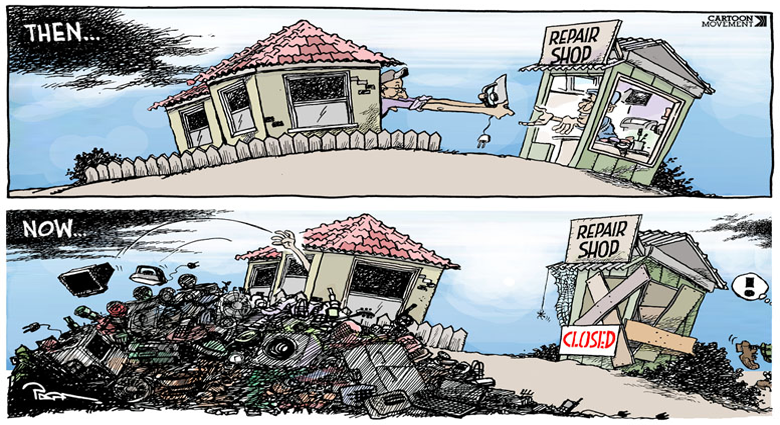There have been a flood of studies of late, looking at how changes in technology, such as the Internet of Thing (IOT) from a consumer standpoint, and the wholesale move to the 'Third Platform' is impacting business.
Most of these studies focused on the technologies themselves: from hardware and software to the new currency of business - the data that is generated by all of this customer-to-digital interaction and how to transform our business and digital operating infrastructure so as to not to be exlipsed by nimbler start-ups, born in the digital age.
It is a huge leap of faith, and many companies won't have the stomach for it.
In all of the conversations about technology-driven transformation, there is one other constant that stands out (possibly more interesting than the hardware and software itself). It's the necessary changes a company must make to its operating model, processes and organizational structure, if it hopes to succeed in the fourth Industrial Revolution.
Organizations' inability to facilitate and accelerate the transformation of their organizational model at or ahead of advancing technologies is an age-old problem. The shame of knowing our inadequacies are still very much alive and in full view, has only amplified the effects of the new world order and has created a space for new firms to step-in and cause all manner of disruption to many traditional business models.
But organizations aren't faceless, empty buildings. They're run by people. Yes, the technology does the heavy lifting but people need to intentionally commission the labor. Dell's global Digital Transformation Index, unveils some of the shortcomings experienced by companies in this area. For instance, the fact that only 41 percent of businesses say the Board is driving digital transformation and one of the top barriers to transformation is a lack of in-house skills and expertise, are obvious indicators.
To try and understand this more deeply, let's look at three of the five attributes of a digital business, as defined by business leaders and used as a measure of success within the Index.
Innovate in Agile Ways
T. Bert Lance, former Director of the Office of Management and Budget believed he could save billions of dollars by only fixing things that were broken. He popularized the term - "If it ain't broke, don't fix it." The tricky thing is - how do we know what is and isn't broken? A business process might work 'fine' in the present day but should we settle for just 'fine'; and will 'fine' sustain the business in the near-future?
Digital start-ups are carving-up the business landscape. In just 3-5 years, 45 percent of businesses believe they may become obsolete. So, what isn't broken today, could well be broken tomorrow. How do we prepare for this?
By welcoming innovation and agility in all its forms, including the sort of innocation that happens in the shadows. An interesting phenomenon has started to take shape in many corporations who are struggling departmentally, with digital transformation. With the advent and availability of Software as a Service and Cloud based applications, users in the business community are not going outside of traditional IT teams and practices to fund and implement new solutions themselves. These are often interpreted as rogue activities that need to be tracked down, assimilated into current infrastructure and governed more closely. This isn't seeing them for what they are: innovative ways to solve real business problems or indivators that some business processes have outlived their sell-by date.
As leaders of transformation what can we do in these situations? We can suspend judgement and explore what's driving this need, because behind every one of these activities there is ultimately a business practice, market need or revenue opportunity that is crying out for change.
By opening our eyes to a new world order and understanding that the physical world of networking, application availability and remote access are no longer limitations for transactional systems or processes, we could, for instance, develop a series of micro services that allow the safe and flexible transfer of data across an exosystem, while saving money and breaking down barriers.
According to the Digital Transformation Index, 70% of businesses admit to not innovating well and in an agile way organization-wide. Clearly, something needs to change. Releasing employees' shackles and opening the door to create ingenuity could be a company's saving grace.
Predict New Opportunities
On the surface this one seems quite simple. Take all the data being generated by enterprise systems such as ERP, Sales, Marketing, Manufacturing and so on, add a dash of Data Science and presto, new opportunities. In practive and through the eyes of different team members, it's a very different story. We will find with the arrival of so many different systems, external and internal options, rapid transformation of business processes and people, there are now only pockets of 'data stability' that can be achieved.
For someone in the traditional reporting space for example this presents an emotional challenge as a stability, accuracy and trend measurement (the staples of historical reporting) are thrown out the window and replaced with a 'free market economy' of reporting and analytic capabilities that can divine insight byt can also be undercut by nay-sayers who questions accuracy or quality. Findings just the right blend between the extremes of accuracy and accountability or innovation and daring is where strong leaders can differentiate themselves and their teams. Unfortunately, predicting the future and being able to act on these opportunities is still the unknown, volatile part of the equation. As the research backs-up: 64 percent of respondents admit to not acting on intelligence in real-time and only 28 percent are measuring progress by looking at their businesses' ability to predict human behavior through data.
Placing the right bets on the right insights is a bit of an art that is still lurking just under the surface of the new era of data science.
Demonstrate Transparency and Trust
When interacting with customers, Transparency and Trust is an easy idea to embrace. Share things like pricing (as Southwest Airline calls it 'Transfarency'), show them the products, features, warranty, return policy, other buyer feedback and let them enjoy the buying experience immensely.
However, when looking inwards toward organizational digital transformation, transparency and trust take on an entirely different meaning. Stop and think about this from the seat of a team member. If I go out on a limb, come-up with a new way of doing things which ultimately fails, should I feel vulnerable, a misfit maybe?
A company's ability to create a safe environment, where team members are encouraged to share ideas, take risks and shake things-up, could be businesses' only way to survive in the new economy.
It is a huge leap of faith, and many companies won't have the stomach for it. They won't be able to overcome the default position of 'how it is not possible to do it that way' or ' we tried that before' or 'how will we have a process to govern this' and fall back into the old analog ways of managing and executing their business objectives. This is reflected in the fact that only 31 percent are demonstrating transparency and trust well and organization-wide. However, if we can pull together those people who do beliee and are willing to put themselves on the line, by embracing opportunities afforded by emerging technologies, then we can truly grow the business through Digital Transformation.
These are just three of the five pillars outlined in the Digital Transformation Index, but they are also the ones that most directly relate to the people and operational side of the equation. By taking the time to recognize the impact of Digital Transformation to organizations, and especially to individuals within them, and then becoming aware of pitfalls of attempting to drive change simply through technology, we can more directly influence business success.





.png)
.jpg)


What Did You Think?